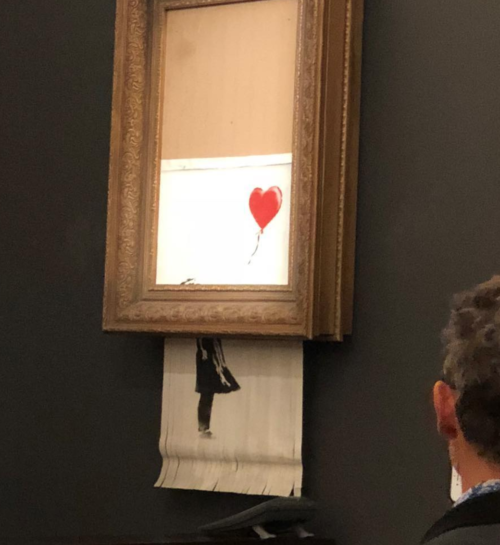While some artists–whether musicians, writers, what have you–only get softer in their old age, it would appear Banksy is just getting warmed up in terms of his first-class reputation as a huckster/enfant terrible. Apparently wanting to continue to maintain his credibility as someone who balks at the absurdity of the rich and what they will spend their money on, Banksy relished the opportunity to make a fool out of the person who felt inclined to spend just over £1 million on his beloved “Girl With Balloon” “painting” (a.k.a. spraypaint on canvas).
No sooner had the hammer come down on the item up for auction than “a man with a detonator” (Banksy himself? Surely not) clicked a button from his perch behind the horde to prompt it to shred before the very eyes of all those beholding it as one of the most valuable pieces of art from a living artist. And as the canvas rent into multiple perfectly destroyed vertical pieces, those present must have been unable to resist looking at it as though watching actual money being annihilated–you know, money that they could have at least used for themselves to, oh, I don’t know, say, pay off the mound of credit card debt that all nouveau riche people tend to end up with. Yes, Banksy’s little “stunt” might have been even more political had the artwork somehow managed to burst into those magical floating pieces of paper called one hundred pound notes (magical mainly because this unit of currency doesn’t exist among bank(sy) notes of the pound sterling).
But regardless of the many capitalists in attendance at the Sotheby’s auction on Friday night to highlight the company’s participation in Frieze Week with a “contemporary art evening” (a mighty white title, but then it’s the British we’re talking about), there is something that Banksy has made us realize both about ourselves and the so-called “meaning” of art.
For one, is art even “good” if it doesn’t fetch millions of dollars and only continue to appreciate in value? Society at large deems the answer to be a no, while Banksy seems to want to remind us that the blending of art and commerce has only opened the door to the allowance of the average or the banal to thrive so long as “the right people” that somehow find themselves in the role of “tastemaker” (as opposed to the more fitting title of tastedestroyer)–in conjunction the ones that can bid millions of pounds after being told what to like–salivate over whatever arbitrarily tickles their pickle.
Secondly, the elusive artist has forced us to reconcile that what hurts people more than the destruction of art is the destruction of money, which is far more illusory and abstract in that it can exist in the very frame of a painting–it is, for the most part, not liquid; intangible and eerily philosophical (one only needs to read George Orwell’s Keep the Aspidistra Flying for the ultimate proof of that). And no one wants to think too closely about how Banksy’s emphasis on “losing” one’s “finances” as easily as a contact lens forces us to realize just how meaningless and ephemeral that which we’re told to focus on for our entire lives is. Usually, only white men have to examine this every once in a while when the stock market goes kabluey. Now, Banksy has taken this reality to the one place most delusional of all about its true motives and incentives: the art world. Loving to tell itself that it is coming from a pure place–that of wanting to “create,” to give back to or somehow beautify the world (or, in contrast, show said world just how ugly it is)–Banksy is flagrantly thumbing his nose at the concept, insisting that art, like every other industry only exists for the purposes of financial gain from both the buyer, the seller (or conduit between buyer and creator) and the artist himself (herself certainly doesn’t apply as women have no parity). And this, too, is precisely why so many “artists” ultimately give up and surrender to the nine to five (so to speak) lifestyle. Because money is more important than anything art can do for them. Or so it has been drilled into their minds by their parents and their government from day one.
In any case, who knows if the saga will continue to unfold? If the buyer will only end up owning something even more “priceless” thanks to the historical value now attached to “Girl With Balloon” (which would lend an added layer of disgust for how “value” is determined in art). Or if Banksy will perhaps come out years from now and say that it wasn’t even an original–just a copy.
In shredding his own work, however, Banksy has also begged the question: does art ever really “belong” to anyone except the artist, who essentially birthed it from the painstaking usage of his mind loins… and therefore can never really be parted from it?






















